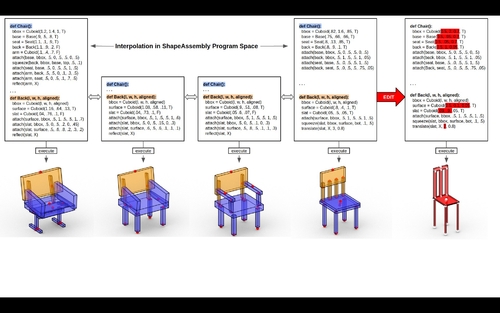Pre-recorded Sessions: From 4 December 2020 | Live Sessions: 10 – 13 December 2020
4 – 13 December 2020
Pre-recorded Sessions: From 4 December 2020 | Live Sessions: 10 – 13 December 2020
4 – 13 December 2020
#SIGGRAPHAsia | #SIGGRAPHAsia2020
#SIGGRAPHAsia | #SIGGRAPHAsia2020











Date/Time:
04 – 13 December 2020
All presentations are available in the virtual platform on-demand.
Lecturer(s):
R. Kenny Jones, Brown University, United States of America
Theresa Barton, Brown University, United States of America
Xianghao Xu, Brown University, United States of America
Kai Wang, Brown University, United States of America
Ellen Jiang, Brown University, United States of America
Paul Guerrero, Adobe Research, United Kingdom
Niloy J. Mitra, University College London (UCL), United Kingdom
Daniel Ritchie, Brown University, United States of America
Bio:
Description: Manually authoring 3D shapes is difficult and time consuming; generative models of 3D shapes offer compelling alternatives. Procedural representations are one such possibility: they offer high-quality and editable results but are difficult to author and often produce outputs with limited diversity. On the other extreme are deep generative models: given enough data, they can learn to generate any class of shape but their outputs have artifacts and the representation is not editable. In this paper, we take a step towards achieving the best of both worlds for novel 3D shape synthesis. First, we propose ShapeAssrmbly, a domain-specific "assembly-language'' for 3D shape structures. ShapeAssembly programs construct shape structures by declaring cuboid part proxies and attaching them to one another, in a hierarchical and symmetrical fashion. ShapeAssembly functions are parameterized with continuous free variables, so that one program structure is able to capture a family of related shapes. We show how to extract ShapeAssembly programs from existing shape structures in the PartNet dataset. Then we train a deep generative model, a hierarchical sequence VAE, that learns to write novel ShapeAssembly programs. Our approach leverages the strengths of each representation: the program captures the subset of shape variability that is interpretable and editable, and the deep generative model captures variability and correlations across shape collections that is hard to express procedurally. We evaluate our approach by comparing shapes output by our generated programs to those from other recent shape structure synthesis models. We find that our generated shapes are more plausible and physically-valid than those of other methods. Additionally, we assess the latent spaces of these models, and find that ours is better structured and produces smoother interpolations. As an application, we use our generative model and differentiable program interpreter to infer and fit shape programs to unstructured geometry, such as point clouds.
